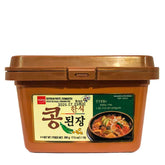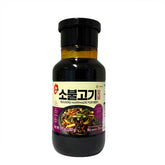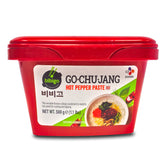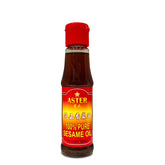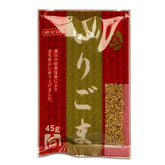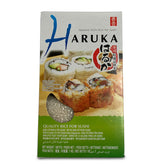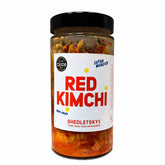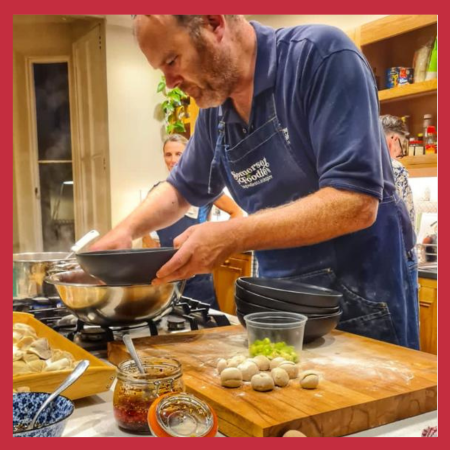Korean Beef Bulgogi Bibimbap
Bulgogi is one of the most famous dishes from Korea, it's seriously tasty. Made using thinly sliced strips of beef that are marinated in soy, garlic, ginger and sesame along with pureed fruit, often pears or apples or a combination of both. The fruit helps tenderise the beef as well as giving the end result a nice sweetness.
Bulgogi is a pretty versatile dish, it's often stir-fried with onion and eaten simply with rice and a few garnishes, in a kind of bibimbap style (like I've done here). However, it's also a popular inclusion in a Korean BBQ, where it's grilled and wrapped in lettuce leaves with kimchi, Ssamjang sauce (a spicy sauce made from fermented soy bean paste and gochujang) and rice - equally delicious.
For this recipe, I've used a rib-eye steak sliced as thinly as possible. To make this easier, a simple trick is to pop the steak in the freezer for around an hour - this will firm everything up and make it easy to slice into really thin strips of beef. The good news is that one steak will go a long way, I've just used one 10 ounce steak that's good for 2/3 portions. Saying all that, this recipe will also work with diced chicken thighs if you prefer.
Your choice of garnishes is pretty interchangable, however I have made a Ssamjang sauce which is really good, easy to make and brings the whole dish together. As for the other garnishes, I've opted for raw sliced carrot, cucumber and spring onions with a soft boiled egg, kimchi and some pickled radish - the pickles are an essential part of the dish to provide balance.
Korean Beef Bulgogi Bibimbap
Serves 2/3
Prep time: 30 minutes plus 1 hour to chill the steak and overnight marinating | Cooking time: 35 minutes
Ingredients
For the beef
300g rib-eye steak, sliced super thinly (you can use sirloin as well)
60g O'Food Bulgogi Marinade for Beef
1 white onion, sliced thinly
A little oil for frying
For the rice
225g Japanese white sushi rice (washed in several changes of water and soaked for 20 minutes)
337ml water
For the ssamjang sauce
1 tablespoons Doenjang (you can substitute miso here which is similar but the doenjang has a stronger, 'funkier' flavour)
½ tablespoon gochujang
1 tablespoons honey
½ tablespoon sesame oil
1 spring onion, trimmed and thinly sliced
2 cloves of garlic, crushed or minced
1 teaspoons of toasted sesame seeds
The rest of the garnishes
2 eggs, boiled for 6 minutes, then cooled and peeled
1-2 carrots, peeled and sliced into julienne strips
¼ cucumber, deseeded and sliced into strips
2 spring onions, trimmed and thinly sliced
Shedletsky's kimchi
Shedletsky's pickled radish
Toasted sesame seeds to garnish
1. First job is to slice and marinade the beef. As with all marinades, it's best if you marinade overnight, but if not, then a couple of hours will make a big difference. Pop the steak in the freezer and cool it right down for around an hour, then slice it as thinly as possible. Pour over the marinade and massage it in until the beef has absorbed almost all the marinade. Transfer to a non metalic container and marinade overnight.
2. The following day, wash the rice in plenty of changes of water then leave for 20 minutes to soak.
3. Bring a small saucepan of water to the boil and drop the eggs in to cook. Boil them for 6 minutes, then remove and chill under running water. Peel them, ready to garnish the dish (slice them in half last minute).
4. I find cooking rice in a heavy, cast iron casserole dish the best method, that's if you don't have a rice cooker. So, grab your heavy pot and bring the 337ml of water to a simmer.
5. Whilst you are waiting for the water to boil, you can make the Ssamjang sauce by simply combining all the ingredients and mixing together.
6. Once the water is simmering and the rice has soaked for 20 minutes, drain the rice from it's soaking water and tip into the simmering water. Place a heavy lid on top and turn the heat down to it's lowest setting. Start a timer for 16 minutes and cook gently. After 16 minutes, turn the heat off and leave for a further 10 minutes. Your rice will be perfectly cooked.
7. Whilst the rice is cooking, finish off the rest of the garnishs - peel and slice the carrots, chop the cucumber and the spring onions.
8. Once the rice has rested in the pot, you can cook the bulgogi, it's pretty quick so fine to do once everything else is ready. Heat a wok or heavy frying pan to medium hot, add a splash of cooking oil and stir-fry the sliced onion for a minute, until it softens. Now add the beef, turn up the heat to maxium and fry for a couple minutes - you want the beef to lightly caramelise.
9. Now it's time to assemble everything. Pile some rice into the centre of each bowl, add some of the beef along with all the other garnishes plus the ssamjang sauce, neatly arranged around the edge. Finish with a sprinkle of toasted sesame seeds.
Enjoy! Foodies, don't forget to leave a review for this recipe below if you enjoyed making this at home.

